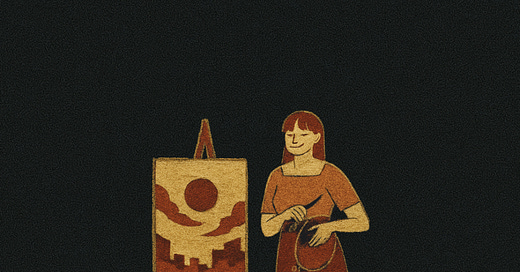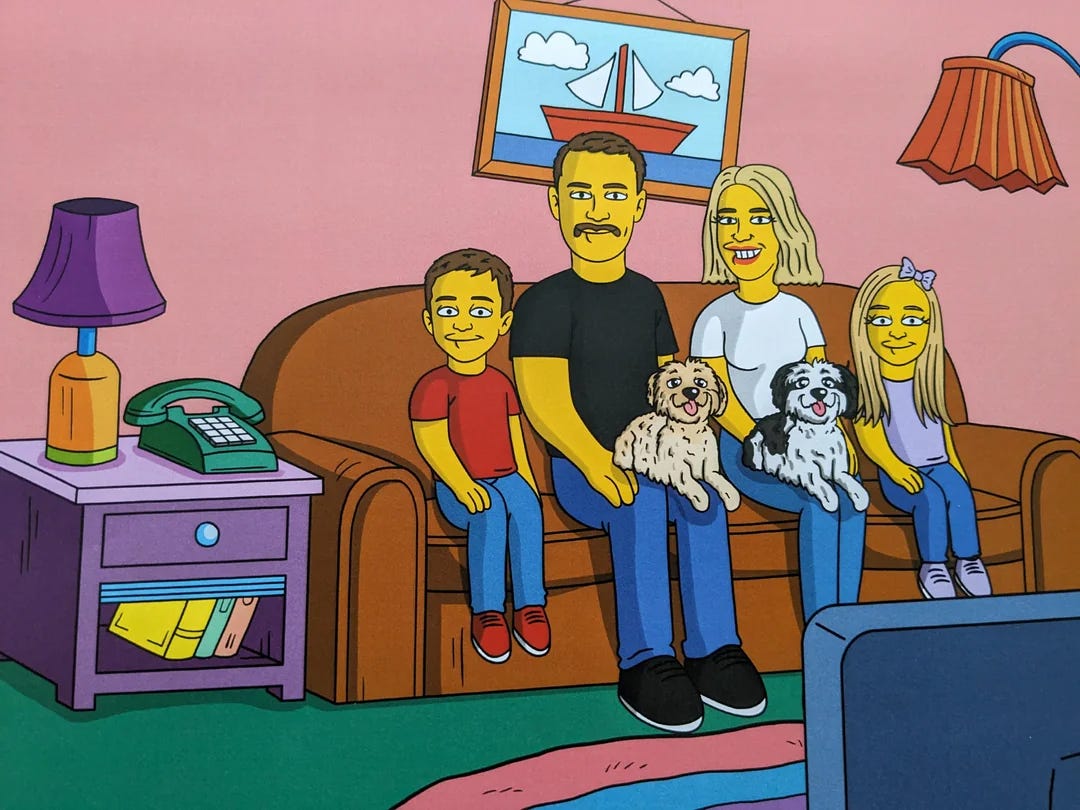The Strange Culture War Over AI Art
viewing the world through the prism of tech bros vs artists
One of the most intriguing aspects of modern culture wars is how they pressure people to abandon ideological consistency in favor of tribalism. A recent example of this is the new left-right divide over AI art, which parallels the political polarization of Silicon Valley and tech capital toward the Trumpist right.
The right has embraced AI art to the point that they’re using it to produce low-effort logos for their political organisations and ‘Ghiblify’ deportations. Meanwhile, many on the left have developed such strong opposition to AI art that they've adopted arguments that seem to contradict their usual ideological positions. I think these arguments are disingenuously employed – the people making them don’t actually believe them – and I’ll try to explain why.
Property Is Theft, but Don’t Steal My Ideas
A common objection to AI art is that it violates the authorship and intellectual property rights of artists. Generative AI tools are trained on vast amounts of data and in some high profile cases that includes copyrighted works used (and often obtained) without the copyright-holder’s consent. These tools enable users to mimic styles and design elements of human artists without providing them with credit or compensation. Is this plagiarism? Is it theft?
Well, that depends on how you feel about private intellectual property rights. Richard Y Chappell explains this better than I can, but to put it simply: private property is typically justified on propertarian or instrumental grounds. Propertarians, think of someone like Ayn Rand, believe that private property – including intellectual property – is a natural right. Instrumentalists, on the other hand, believe that private property rights are only valuable insofar as they’re good for society. They’re a legal fiction, not a natural right. Personally speaking, I spent my formative years on the internet arguing with American libertarians – the most steadfast propertarians – and even they tend to be sceptical of intellectual property rights for creative works.
Intellectual property protections are generally justified instrumentally: they make socially beneficial enterprises profitable and encourage innovation. Chappell notes how we should be cautious about granting strong intellectual property rights without compelling instrumental reasons, which are notably absent in the case of generative AI:
Imagine an artist in a patriarchal society complaining when women are allowed into the art museum for the first time: “I never gave permission for women to view my art!” This artist has no legitimate moral complaint, I’d say, because he has no moral right to make his work accessible only to men. Likewise, artists have no moral right to make their work accessible only to humans. They have no legitimate complaint if an AI trains on the work they post online, any more than they can complain about a young human artist “training on” (or learning from) their work. In claiming such veto powers—demanding that their permission be sought before such actions are undertaken—the artists are claiming power over others without adequate basis. […] There is no utilitarian justification for those rights, and they are not the sorts of rights that could exist without a utilitarian justification. - Richard Y Chappell, ‘There’s No Moral Objection to AI Art
Leftists, of course, are typically the most sceptical of strong private property rights. Socialists and communists in particular define themselves in opposition to an economic order characterised by the preponderance of private ownership. Additionally, there’s a long history of progressives supporting media piracy on freedom of information grounds and more left-leaning individuals are more likely to use pirated streaming websites. Regardless of the merits of the intellectual property argument, it’s unusual that it’s coming from the left.
Effort Moralism
Another claim is that using generative AI to make art is lazy. Anyone can write ‘Turn this image into Studio Ghibli anime style’ and send ChatGPT a photo of their dog, but becoming a "real" artist requires hard work and dedication. Using AI is characterized as "cheating," even when users transparently acknowledge their use of generative tools.
But this confuses difficulty and effort with moral permissibility. Everyone can appreciate the difference between the hard work that goes into painting the Mona Lisa and asking ChatGPT to make something in the style of Leonardo da Vinci without declaring the latter immoral. The concept of "cheating" implies art is a competition with agreed-upon rules, rather than something that people engage with for their personal enjoyment.
Supporters of AI art say that generative AI has made art accessible to the wider public, but detractors reply that art has always been accessible – anyone can pick up a pencil. And sure, that’s mostly true (some disabled people notwithstanding), but not everyone has the time or ability to produce what they want. Some of us will never be able to draw or paint in our preferred style. The ability to transpose one’s imagination onto a canvas is something that takes time, effort and talent to achieve – it doesn’t seem like there’s a good reason to believe it’s wrong for someone to use generative AI to do that for them.
When faced with this reply, detractors will point out that the lazy and untalented can always commission artists instead of using ChatGPT. But again, not everyone has the money to commission a sufficiently skilled artist. Generative AI plays a democratising role by allowing anyone with a computer or smartphone to have their own court artists and musicians, not just the rich.
Again, it strikes me that these criticisms of AI art sound almost parodically conservative. Using AI is treated as a moral failing because it’s lazy and it’s ‘cheating’. People just need to pull themselves up by the bootstraps and put some effort in, or at the very least, they should be able to pay someone to do it for them rather than using a free tool. This perspective aligns more with meritocratic conservatism than with progressive ideals of accessibility and democratisation.
The Slop Heap
The final criticism I’ll address, which is perhaps the most common, is that AI art is just… missing something. It doesn’t convey real, genuine beauty or awe-inspiring sublimity. It’s inauthentic. It doesn’t matter what these terms mean – you know what I mean – what matters is AI art doesn’t have that special something that you find in man-made art. It’s soulless, it’s kitsch, it’s slop.
But none of this is unique to generative AI. You can find plenty of artists willing to draw pictures in the style of The Simpsons and plenty of customers willing to pay to see themselves or their loved ones in that style. Just google ‘Simpsons Fiverr’ and you’ll find plenty of people selling ‘Draw you and your family as a famous yellow cartoon’ for anywhere from $5 to over $100. You’ll also notice that most of these drawings are awful. Many bear only a superficial resemblance to Matt Groening’s work, some are obviously using pre-made assets, and others fail to strike a balance between accurately portraying real people and drawing a children’s cartoon.
Even the artists that manage to do it well are still producing unoriginal and uninteresting work. A good drawing of someone’s family in the style of The Simpsons is still a derivative work. And that’s okay. Some people engage with art because they appreciate novelty and creativity, others care about technical prowess, and others still just want to see what they’d look like as a Disney character. Let people enjoy things.
Moreover, the line between ‘authentic’ human creativity and AI assistance is increasingly blurry. Artists have always used tools like brushes, cameras and nowadays digital software. Photography was once dismissed as mere mechanical reproduction rather than art before it eventually recognition as a legitimate artistic medium. I suspect AI tools will follow a similar trajectory and gradually become integrated into artistic practice.
It’s All Displacement
A few years ago, Freddie DeBoer responded to the media backlash against Substack by suggesting that it’s ‘All Just Displacement’. Journalism is a cut throat industry known for low pay, crappy conditions and broken dreams. I think the same kind of phenomenon is taking place here. The art world is in a similarly bad place and now it’s seemingly under threat from a tech sector that’s explicitly marching towards the singularity – the triumph of machine over man, technology over tradition, tech bro over art snob.
It’s one of the dumbest culture war issues, but in a way it feels very material. The two camps are clearly divided among the two professions they choose to support: the artists or the programmers. Those on the left fear the displacement of their indie artist friends and those on the right relish at the prospect of telling left-leaning artists to ‘learn to code’.
As with any other technological development throughout history, the issue is not with whether to embrace or reject new technology. Rather, the issue is how we can ensure that generative AI serves human flourishing and how we can ensure a just transition for those it displaces.






I have commented elsewhere that one of the hilarious ironies I have witnessed in this particular culture war battleground of AI art is the amount of fanart creators who hate on AI. People who have been guiltlessly ripping off the IP of major studios for decades are now sad that someone invented a DevientArt Machine, and they're mad that people might not buy $35 commissions of their "OC" My Little Pony character from them anymore. I don't actually mind fanart existing, nor do I mind them ripping off IP, but don't pretend that being anti-AI is at all logically consistent with that.
Another irony that gets forgotten is that art emerges through inequality. I read The Dawn of Everything recently and one uncomfortable truth that emerged was that great art traditions, like the Haida from the west coast of North America, can emerge from slave cultures.
Artists need to be freed from life-sustaining labour to be able to develop their skill and produce their works. This necessarily means that labour must be reproduced by others in the culture. All the gilded ages have produced a lot of gild on the backs of working people by the rich who have the surplus to sustain the creative class.
In essence we always have had a parasite class that eats our dreams and shits out beauty.
Full disclosure, I am one of the creative class that is sustained by this process.
Some fear that AI will cut out the creative class, to just smooth out the transaction. I don’t think it will, although it will make it harder for marginal creatives to live and favour the mediocrity of the trust fund kids.